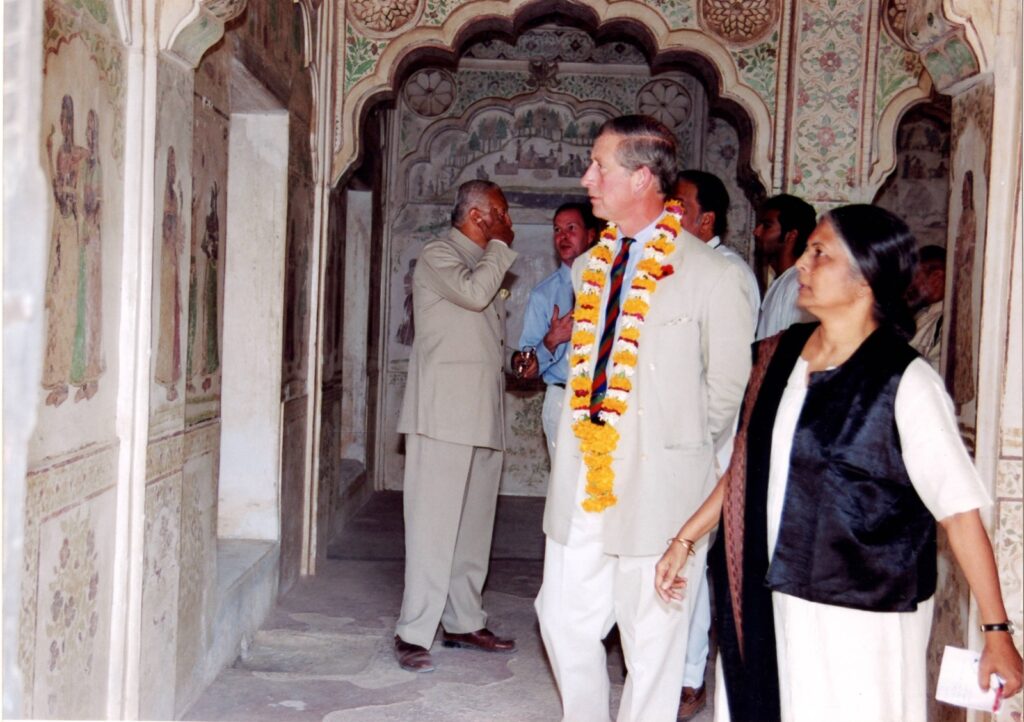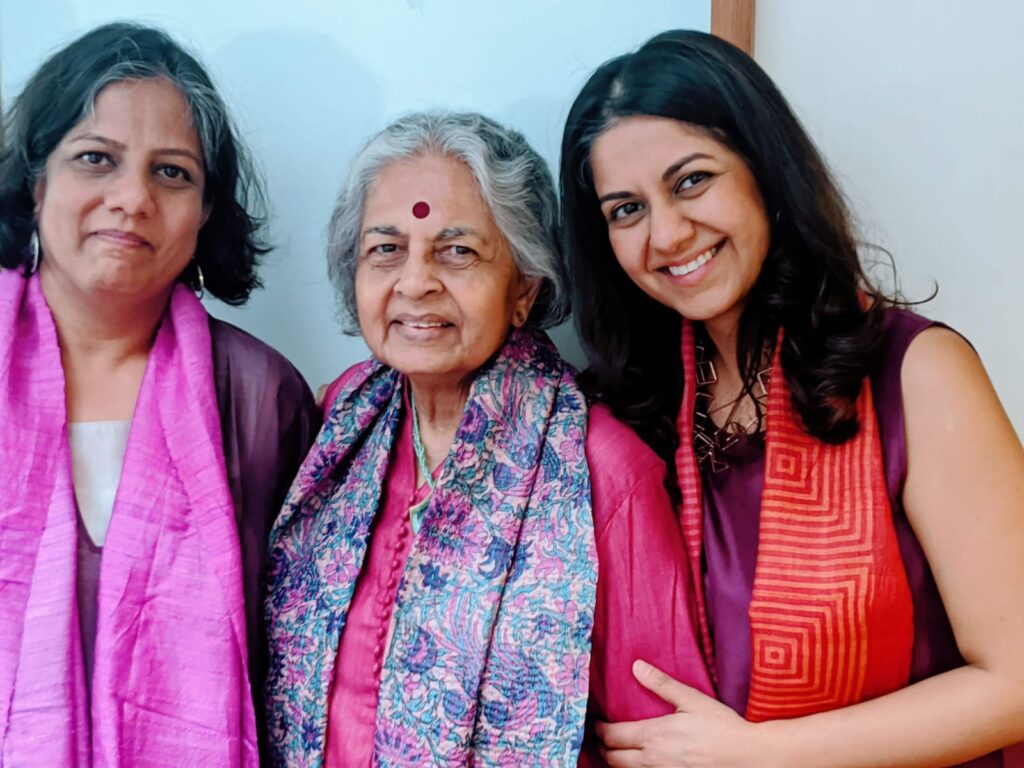Minakshi Jain, like many professional women in her generation, wore many hats: mother, wife, teacher, practising architect, employer, host, and colleague.
In my 50-year journey with her, I saw her in all of these roles, and today, it is very difficult to separate them out. She was a very gracious and elegant host, and our home was always welcoming all kinds of people; family, fellow architects and designers, friends, members of the charitable organizations she worked with, and office staff. Throughout my school and college days, my friends were welcome at all times without any hesitation. Now that I think of it, it was incredible that she would manage to have 30 odd young people for dinner after a full day at the office. She said that it came from her own home, which saw a lot of comings and goings. She would have preferred even more.
To her, frugal was a design opportunity.
She had a very strong belief in a frugal and elegant way of life. To her, frugal was a design opportunity. She made sure there was no waste in our house. I still have bags of scraps of cloth collected over the years. Sometime back, when she had cut down on her office timings, she sewed them together as quilts. She was extremely skilled in tailoring, having learned it by observing the tailor at her childhood home. After a whole day’s work in the office, she would sit at night so that the next day we had new clothes! She would meticulously design each piece, in terms of the fabric, colour palette, and patterns. She made sure I learned to sew, and it gave her immense pleasure to see me at the sewing machine stitching my daughter’s pyjamas – that’s about all I managed!
The sensibility for design was so intrinsic and inherent in her, we just took it for granted. It was not only about her professional work. The selection of her sarees, jewellery, the fabrics in the house, or the plating at the dining table—all of these collectively represented her innate design attitude. It was a way of life for her.
Though she attributed it to the time spent with Kahn at Penn, the Eameses, and other designers at NID, I believe she was a natural, considering her ability to transfer it into her everyday life. During my father’s term at the University of British Columbia, Vancouver, she learned pottery. She made some of the most beautiful jewellery—pendants and necklaces which are my sister’s and my most treasured inheritance. Plates, vases, and pots with her signature in some incredible combinations of earthy tones became part of our kitchen. In more recent times, we spoke of putting together a pottery studio for her, but it was not to be.

Her penchant for design was more evident in her care for detail than about a larger whole, a characteristic that was most suitable when she became involved in conservation. It was as a conservation architect that she found her calling. One of the early practitioners of the profession, when there were hardly any formal programmes in the country, set out on a journey to conserve one of the largest non-government precincts.
Her persistence and ability to learn and adapt became core anchors in that journey. She was like a sponge, absorbing from the craftspeople on the site, the patrons, visiting guests, and fellow professionals so that she could give it back to the project.
She was totally consumed by the Nagaur Fort for years, leading to an association lasting 40 years. Meticulously, piece by piece, she guided the initiative to restore the fort. Once, she rushed to Nagaur by car in a 14-hour drive because she received a call at night that some particular connection to a fountain, they had been looking for, was spouting water. This, when she was susceptible to motion sickness and disliked even an hour-long drive! She gained the respect of her clients, advisors, patrons, consultants, engineers, and craftspeople through her dedication and commitment, never forcing it, but pursuing it with patience. Sometimes she waited for months for the Board of Trustees to approve her suggestions, never becoming aggressive or impatient. I would ask her about it, and she said, ‘Meghal, it is important for them to be convinced, since it then becomes part of their legacy.’ She was very conscious of the responsibility she held towards all the stakeholders in the project. She brought tremendous integrity to what she did, rising to prominence in a quiet way.
She did not seek glory, or recognition, but remained very unassuming of her achievements; she brought to this country the distinction of the first UNESCO Award of Excellence.
Getty repeated their grant three times, a rare occurrence because of her dedicated work as well as her frugal and appropriate use of the funds. She went into the project with full awareness that she had great learning ahead of her, but she was not deterred. She was often apprehensive about her ability to handle the scale of work. Her efforts resulted in being invited by the Government of Rajasthan to conserve the palace at Amber, the Jantar Mantar, the Hawa Mahal, and the Gagraun fort; all significant monuments in the country. For a duration of 10 years, between 2002 and 2012, she travelled to all these places, and we joined her in a partnership. I got to see her more often as a professional, working together on a daily basis. She was a task master, highly disciplined, and extremely focused on her work, compelling all the others on the team to bring the same level of focus and drive to the projects. I had no leverage with her in the professional domain, to the extent that this year she wanted my father and me to work on a book, to which we were not giving time, so she emailed us a meeting time. This, of course, we had to respond to. The meeting was held, and the last communication from her was an email with the minutes of the meeting. We hope to be able to complete that book in the months to come. Through the trust that she set up with my father, the AADI Centre, we would like to continue her legacy of sharing and encouraging young professionals.

In the last few years, she gained tremendous satisfaction from sharing her learnings with younger academics and students through regular on-site workshops at the Ahhichatragarh Fort. She was always very excited to invite new people to visit the fort, share their knowledge, and guide the participants through the process. The team of the fort was as much her family as we were, nurtured through her ability to create a personal rapport with people. She would always enquire about the well-being of all the people on her team and their families and solicit personal and social advice from them. She believed that if it was well-intentioned, there was no reason not to make a suggestion that came from experience.
After her passing, so many people have reached out, speaking of her presence in their lives, both in India and abroad. She had started teaching at CEPT (at that time, the School of Architecture) in the 1970s. Recently, I was told that she was the only woman teacher on campus at the time and a role model for many of the young girls. But she never saw herself in that light, nor did she dwell on it much. It probably came from her family background—her parents were both followers of Shrimad Rajchandra and instilled a strong sense of living without encumbrances.
Her focus was on the present, the action to be taken for a better present. In that sense, I can say with satisfaction that she lived a very active life. It was one of fierce independence, yet deeply connected to us.
Featured Image: Minaskhi Jain at her weekend home. Picture: Meghal Arya
Also read:








9 Responses
I feel so humbled at my dear sister’s life and achievements. Also the importance of family values that we all unknowingly inherited. Meghal you hv brought out so beautifully her life,and work.
As I have started my carrier Adani Architect with Ar.Minakshi Ma’am at 1988, Still til thus day, I am always welcome at her home..She was very remarkable, confident personality of her time.We as an architects always admire her of what she was. Offcourse it was such a proud pleasure of working von Nagaur Restoration Project first report.. Ma’am called up at my home that time to work with her..That loving hearted welcome is to cherish. She drove at Abhikram office to invite me for Meghal’s wedding.. that was the talk of the day in the office itself.. I wish her soul to be cherish n rest in love , peace .
Righty said .She was and will be a great inspiration to all.. I feel fortunate to worked with her .
I am absolutely privileged to be in presence of my masi (mom’s elder sister) since I can remember. I have such found memories of growing up, spending summer time in Ahmedabad, eating fruits and ice cream. I distinctly remember her telling me to do things that helps society and to instill that vision in my kid. Always loved being around her and she will be missed. I can’t imagine going to Ahmedabad and not being able to hug her! Miss you dearly.
A rare combination of humility, talent , patience and dedication.
One of the first and finest conservation architects of India .
Very nicely written article which conveys the different layers of her personality.
She was my guide for my Thesis and I also worked on Nagaur documentation under her guidance. I could sense her simplicity and personality and I am sure she will continue to be a source of inspiration to all colleagues and students in SPIRIT.
She was our guide at cept in 1987 ,the pre final year studio and handled our young rebellious bunch with grace , calm and poise . A bunch of us were lucky to have met her one last time at her home last year.
Beautiful tribute, Meghal! She looks radiant! We all came over so often to your place. Fondest of memories. Open, simple and minimal, these are our eternal learnings from your parents. Difficult to practice…
Condolences to the Jain family In what words I will be able to share that Meena mam was a most wonderful teacher. We did travel to Nagaur only few times but the knowledge she passed on to me, I was speechless ……. and still am. Its like she opened the doors of the book shelf and left up to me which one to choose . When I used to write her about the progress, work I was eager to hear from her and she never missed to email me back. In delicate moments and tough times she has always been an advisor. Hope I can give justice to the path I have chosen as she has .